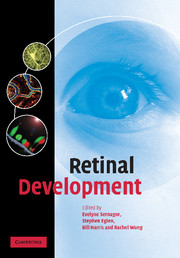Book contents
- Frontmatter
- Contents
- List of contributors
- Foreword
- Preface
- Acknowledgements
- 1 Introduction – from eye field to eyesight
- 2 Formation of the eye field
- 3 Retinal neurogenesis
- 4 Cell migration
- 5 Cell determination
- 6 Neurotransmitters and neurotrophins
- 7 Comparison of development of the primate fovea centralis with peripheral retina
- 8 Optic nerve formation
- 9 Glial cells in the developing retina
- 10 Retinal mosaics
- 11 Programmed cell death
- 12 Dendritic growth
- 13 Synaptogenesis and early neural activity
- 14 Emergence of light responses
- New perspectives
- Index
- Plate section
- References
8 - Optic nerve formation
Published online by Cambridge University Press: 22 August 2009
- Frontmatter
- Contents
- List of contributors
- Foreword
- Preface
- Acknowledgements
- 1 Introduction – from eye field to eyesight
- 2 Formation of the eye field
- 3 Retinal neurogenesis
- 4 Cell migration
- 5 Cell determination
- 6 Neurotransmitters and neurotrophins
- 7 Comparison of development of the primate fovea centralis with peripheral retina
- 8 Optic nerve formation
- 9 Glial cells in the developing retina
- 10 Retinal mosaics
- 11 Programmed cell death
- 12 Dendritic growth
- 13 Synaptogenesis and early neural activity
- 14 Emergence of light responses
- New perspectives
- Index
- Plate section
- References
Summary
Introduction
The optic nerve is the anatomical pathway through which visual information received in the retina is conveyed along the axons of retinal ganglion cells (RGCs) to central visual targets for processing. In terms of its cellular organization, the optic nerve is relatively simple compared with other white matter tracts in the CNS. Unlike most CNS axon pathways, which typically contain ascending and descending axons from multiple neuronal populations, axons within the optic nerve all originate from RGCs in the eye, and all project in the same direction away from the retina towards the brain. There are no neurons in the optic nerve, and all resident cell nuclei belong to optic nerve glial cells. Given these organizational features, the developing optic nerve is an attractive experimental system and, not surprisingly, has been widely used in studies of axon guidance, glial differentiation, glial migration and myelination. Similarly, the adult optic nerve has also served extremely well as a model for studies of axonal transport and axon regeneration. This chapter describes the developmental mechanisms governing major aspects of optic nerve formation such as the determination of optic stalk cell fate, axon guidance and glia migration. The aim is to highlight our current understanding of these developmental processes, which at a basic level are fundamental to development of all regions of the nervous system.
Phases of optic nerve development
In considering optic nerve development, it is useful to conceptually divide the process into three phases.
- Type
- Chapter
- Information
- Retinal Development , pp. 150 - 171Publisher: Cambridge University PressPrint publication year: 2006
References
- 1
- Cited by



